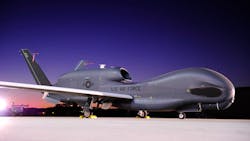2021 DOD budget would cut procurement, boost research, retire 24 Global Hawk UAVs and four Navy cruisers
WASHINGTON – The U.S. Department of Defense (DOD) in 2021 plans to reduce procurement, increase research and development, and retire ageing manned aircraft, unmanned aerial vehicles (UAVs), and surface warships.
DOD leaders in their fiscal 2021 budget request to Congress, which was released on Monday, are asking for $705.4 billion, which is down about 1 percent from this year's level of $712.6 billion.
The DOD's procurement budget request for 2021 is $136.9 billion, down nearly 7 percent from this year's level of $147.1 billion. The Pentagon's procurement budget is where many of the big-ticket military programs are, and accounts for new ships, planes, combat vehicles, and the like.
The DOD's 2021 budget request for research, development, test, and evaluation is $106.6 billion, which is up about 1 percent from this year's research budget of $106.6 billion. Military research develops new enabling technologies for the weapons systems of tomorrow.
One big issue in the 2021 DOD budget is the planned aggressive retirement of relatively old military aircraft, surface warships, and land systems that do no align with the so-called 2018 National Defense Strategy, which seeks to revitalize U.S. military capability against near-peer foes like China and Russia.
Instead, military leaders will use the money they save from retiring these systems to help pay for new weapons and enabling technologies. All of these so-called divestitures should save the DOD about $1 billion, officials say.
The U.S. Air Force will retire 24 RQ-4 Block 20 and Block 30 Global Hawk Battlefield Airborne Communications Node (BACN) unmanned aerial vehicles (UAVs) and Block 30 multi-intelligence aircraft UAVs next year. Instead, officials will rely on the Air Force fleet of manned E-11s -- militarized versions of the Bombardier BD-700 Global Express business jet -- for the BACN role.
The U.S. Navy, meanwhile, will retire four Ticonderoga-class missile cruisers next year -- the USS Monterey (CG 61), USS Shiloh (CG-67, USS Vella Gulf (CG 72), and USS Port Royal (CG 73). These ships, DOD officials say, are the Navy’s least capable missile-defense ships, and will be decommissioned with more than 30 years of service.
U.S. Army leaders plan to eliminate 13 programs involving munitions, fires, protection, sustainment, mobility, mission command, and cyber programs that no longer are priorities.
For high-priority programs, the DOD next year plans to spend $18 billion for space initiatives, including $15.4 billion for operations, procurement, and research for the new U.S. Space Force; $9.8 billion for cyber security and cyber warfare -- up 81 percent from $5.4 billion this year; $4.2 billion for nuclear command, control, and communications research; $3.2 billion for hypersonics; $1.5 billion for military microelectronics and 5G networking; and $800 million for artificial intelligence (AI) research.
The Pentagon hypersonics budget will pay for research and development initiatives to develop the Army Long-Range Hypersonic Weapon; Navy Conventional Prompt Strike (CPS); and Air Force Advanced Rapid Response Weapon (ARRW).
For weapons and military systems, the Pentagon plans next year to spend
-- $3 billion to buy 15 KC-46 aerial tankers; -- $1.2 billion for 52 AH-64E Guardian attack helicopters; -- $876 million for 639 advanced medium-range air-to-air missiles (AMRAAM); -- $577 million for 400 Joint Air Surface Standoff Missiles - Extended Range (JASSM-ER); -- $4.7 billion for one Virginia-class fast-attack submarine; -- $3.5 billion for two Arleigh Burke-class destroyers; -- $1.1 billion for the Navy's next-generation frigate; -- $4.4 billion for the future Columbia-class ballistic missile submarine; -- $464 million for two Large Unmanned Surface Vessels; -- $224 million for 53 long-range anti-ship missiles (LRASM);Related: Air Force eyes digital transformation in 2021 budget
-- $603 million for 203 Tactical Tomahawk missiles --including some with maritime strike capability;
-- $6.9 billion for armored combat vehicles -- including 4,247 joint light tactical vehicles (JLTVs), and 72 Amphibious combat vehicles;
-- $1.5 billion for the Ground Based Strategic Deterrent next-generation nuclear ballistic missile;
-- $2.8 billion for the future B-21 bomber;
-- $474 million for the future Long-Range Stand-Off Weapon air-launched nuclear cruise missile;
-- $11.4 billion for 79 F-35 joint strike fighters;
-- $1.6 million for 12 F-15EX jet fighters;
-- $2.1 billion for 24 F/A-18E/F Super Hornet jet fighter-bombers;
-- $1.5 billion for seven CH-53K King Stallion heavy-lift helicopters; and
-- $1.1 billion for four E-2D Advanced Hawkeye radar surveillance aircraft.
Next year the Navy plans no purchases of additional P-8A Poseidon maritime patrol aircraft; MQ-4 Triton long-range maritime patrol UAV; or the MQ-25 Stingray UAV.
About the Author
John Keller
Editor-in-Chief
John Keller is the Editor-in-Chief, Military & Aerospace Electronics Magazine--provides extensive coverage and analysis of enabling electronics and optoelectronic technologies in military, space and commercial aviation applications. John has been a member of the Military & Aerospace Electronics staff since 1989 and chief editor since 1995.
